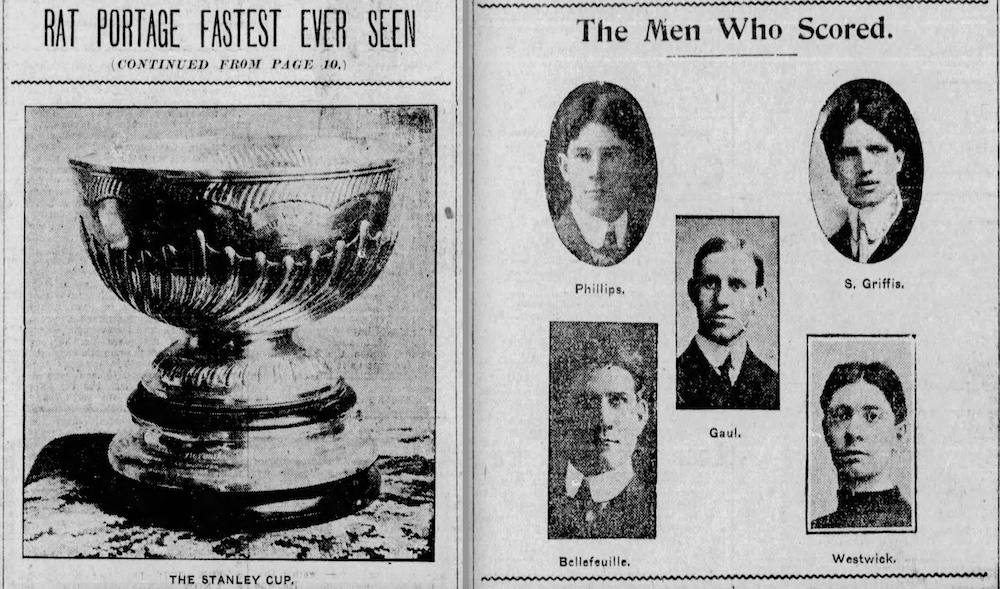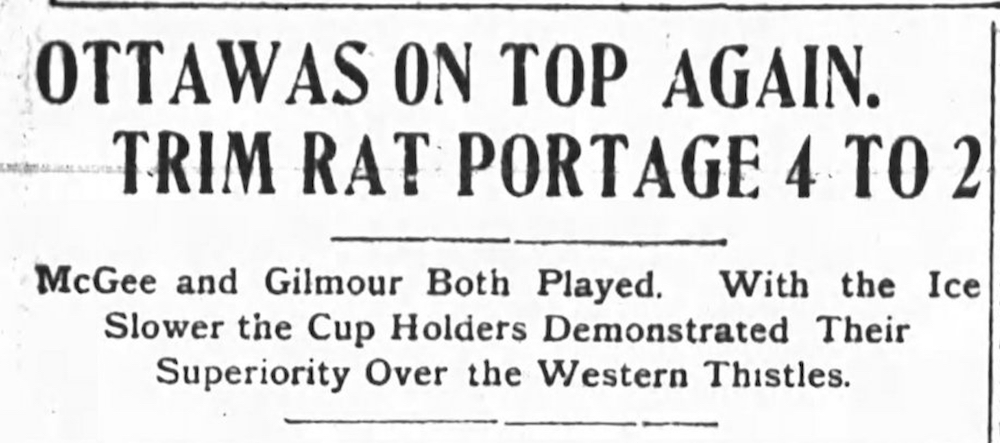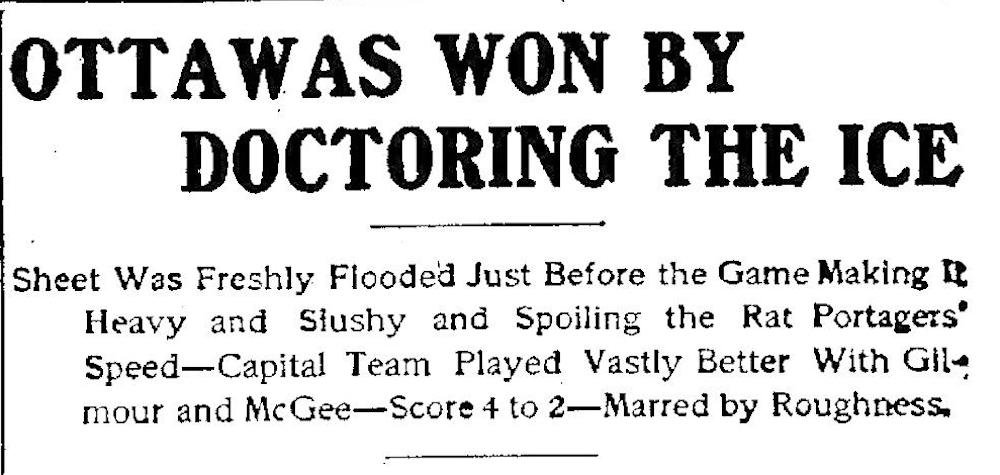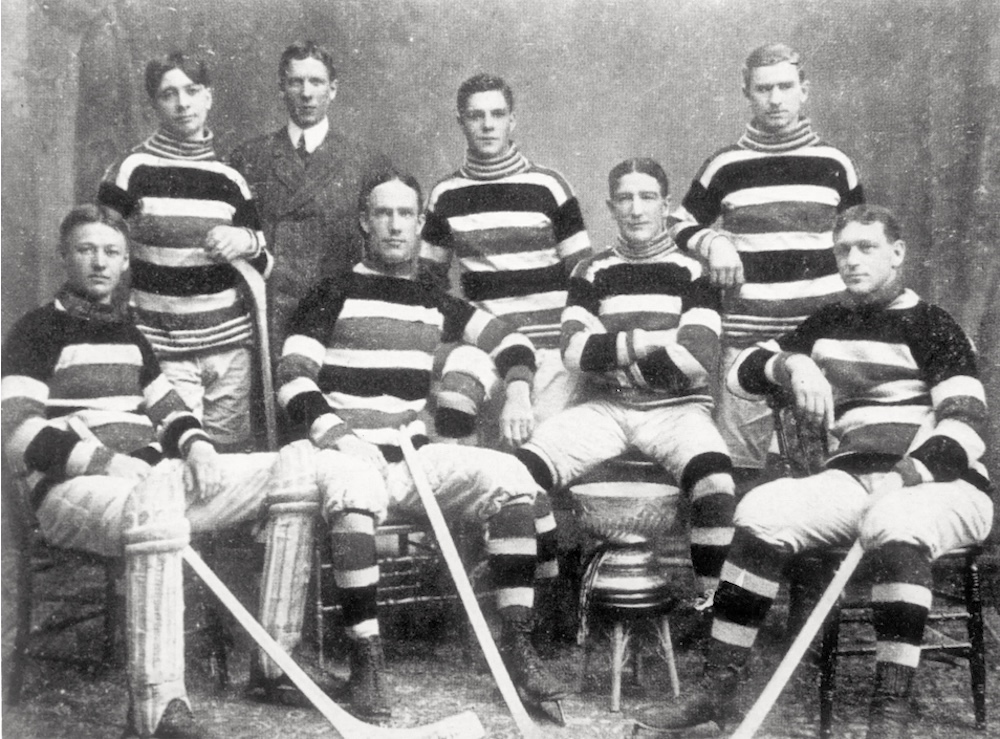If all continues to go according to schedule, by early May you’ll finally be able to read my new book Engraved in History: The Story of the Stanley Cup champion Kenora Thistles. With the NHL season scheduled to end on April 29, and the Stanley Cup playoffs expected to start on May 2 (and quite possibly run until late June), I hope we’ll be able to generate some good buzz for the book during that time.
In my most recent post from last month, you may recall Evelyn Gunne of Kenora singing:
Three times you’ve tried to win, boys,
“Three times and out,” they say,
But now the Cup is ours, boys,
For you’ve brought it home to stay.
The Thistles, who beat the Montreal Wanderers in 1907, had first gone after the Stanley Cup in March of 1903, when Kenora was still known as Rat Portage. They faced Ottawa that year and were beaten rather easily in two straight games in a best-of-three series by the soon-to-be legendary Silver Seven. Everyone seemed to agree the Thistles were too young and unproven to win the Cup that year, but that they would be back.
Indeed they would.

Two years later – on March 7, March 9 and March 11, 1905 – Rat Portage (the town name wouldn’t change to Kenora for another two months) took on Ottawa for the Stanley Cup again in another best-of-three series. Hockey fans who know anything about the history of this era are likely to know of Ottawa trouncing Dawson City 9-2 and 23-2 (behind 14 goals from Frank McGee) in January of 1905. The Ottawa-Dawson series might be the most famous from the Stanley Cup’s early “Challenge Era,” but the Silver Seven versus the Thistles that March was easily the greatest series of that time.
The Rat Portage Thistles of 1904-05 were a powerhouse. Playing in the Manitoba Hockey League with the Victorias and the Rowing Club of Winnipeg, as well Brandon and Portage la Prairie, the Thistles were overwhelming favourites for the league title. They began their season on January 2, 1905, with a 14-2 win over Portage. After a shocking 3-2 loss to the Rowing Club, Rat Portage finished the season (hockey schedules were MUCH shorter in those days!) with six straight wins. The Thistles ended the 8-game season with a 7-and-1 record and outscored their opponents 81-22. The average score in their seven victories was close to 11-3.

The high scores, in those years and others, are the reason why there times in the book when I draw comparisons between the 1900s Thistles and the 1980s Edmonton Oilers.
The Thistles, of course, are remembered today because of the 1907 championship which made Kenora the smallest town ever to win the Stanley Cup. And yet star player Si Griffis thought the 1905 Rat Portage squad was actually the better team. (In the Edmonton analogy, Griffis would be the Thistles’ Mark Messier to captain Tommy Phillips’ Wayne Gretzky.) With a group of stars who excelled in speed and had the stamina to play the full 60 minutes without tiring, Griffis was quoted in a story for the Winnipeg Tribune on August 29, 1914, as saying, “I believe our seven of that season was the greatest ever placed on the ice.”
“Ottawa…” said Griffis of the 1905 team, “were better stickhandlers than the Thistles … [but as] a team, we excelled Ottawa.”
Rat Portage just didn’t get the breaks that year.

after Game One between Rat Portage and Ottawa.
If the Thistles of this era were the 1980s Edmonton Oilers, then the Ottawa team of the 1900s was the 1970s Philadelphia Flyers. The Silver Seven were talented, but they were tough … and they were dirty too. So when the Thistles challenged for the Stanley Cup in 1905, they asked for the new two-referee system that had been used for the first time that year in the Manitoba Hockey League.
Ottawa refused.
However, the trustees who oversaw Stanley Cup competition ordered that game one be played with the two-referee system (a referee and a judge-of-play), and game two with just a single referee. If a third game was needed — which it would be — there would be a referee and a judge of play in the first half but just the referee in the second. (Hockey was played with two 30-minute halves until the 1910-11 season.)
Like the Thistles, Ottawa had posted a 7-and-1 record in 1904-05. Playing in the Federal Amateur Hockey League with the Montreal Wanderers, Montreal Montagnards and teams in Brockville and Cornwall, Ontario, the Silver Seven outscored their opponents 60-19. Throw in the Stanley Cup victory against Dawson City in January, and Ottawa was 9-and-1 with 92 goals scored and only 23 goals against. Still, fans in the Canadian capital knew the competition hadn’t been great that winter and looked forward to a real test from the Thistles.

But no one could have expected what happened in game one!
Playing on hard, fast ice with two officials to call penalties, the Thistles stunned Ottawa with a 9-3 victory. Tommy Phillips scored five goals. (Some sources say six). Griffis added a pair and the two stars were recognized as the best players on the ice.
Ottawa had played that first game without future Hall of Famers Billy Gilmour and the great Frank McGee — who was Tommy Phillips’ only rival as the best player in hockey at this time. Both were back for game two, and with only one referee that night, Ottawa played much rougher.

“The second game of this series was the most punishing that I, or for that matter, any member of the old Thistles was ever in,” Griffis recalled for the 1914 Winnipeg Tribune story. “I don’t remember exactly what the other players received for their share, but I left the ice with my nose broken in two places, the first time by McGee, who was equally proficient in using the butt of his stick for jabbing as the other end for shooting purposes. Later on, I had it knocked back in position by Alf Smith.
“Players did not wear as many pads in those days as they do now,” Griffis continued, “and from having the wood laid on I had water on the knees, elbows, and hips. Even as late as today I have tangible evidence of the milling that I went through in Ottawa.”

The state of the ice in game two drew at least as much attention as the injuries and rough play in the newspapers the next day.
In the Capital, papers only remarked on the “slow” or “heavy” conditions, but elsewhere across Canada, fans were more than willing to believe the worst about Ottawa’s Silver Sluggers! In later years it would be claimed that after Rat Portage’s easy victory in game one, the Ottawa ice crew at Dey’s Arena, or possibly even the Ottawa fans, salted the playing surface in a deliberate attempt to slow down the Thistles in game two.
That probably wasn’t true.

However, it is possible that the ice was flooded a little too close to game time to allow it to freeze into a hard, fast surface. That’s what Griffis believed, although he didn’t think the Ottawa club had anything to do with it.
Still, “Ottawas Won by Doctoring the Ice,” cried the front-page headline in the Manitoba Free Press the morning after game two.
Soft ice wasn’t a problem for the final game of the 1905 series, and playing with the two-referee system in the first period, the Thistles led 2-1. Even with just the one referee, there were plenty of penalties called in the second half. Phillips and McGee traded hat tricks in the game, and Ottawa rallied for a 5-4 victory on a late goal by McGee. Yet everyone seemed to agree the Thistles would have tied it if there had been just a little more time left to play.

These were the headlines in the Ottawa Citizen on Monday.
“It was a hard fought game on the part of both teams,” said referee Mike Grant. “I do not care to say anything about the relative merits of the two teams, but it was anyone’s game until the final whistle sounded…. It was a great game of hockey, easily the best ever played for the Cup.”
Tommy Phillips, speaking for his team, said: “We were beaten, but only by the closest possible margin…. We led for three-quarters the distance and were only beaten under the wire by a nose. The gong saved the Cup-holders. The way the play was going we were sure of a score within a few minutes.”
“A couple of minutes more and they would have won,” said the Thistles’ honourary president Dr. Nelson Schnarr, speaking on behalf of the club executive. Schnarr added that he “really believed” the results might have been different if the judge of play had been used in the second half, “but it’s no disgrace to be beaten by a team of the calibre of the Ottawas.

“I’m proud of the Rat Portage boys,” said Schnarr, “as proud of them in defeat as in victory. Where will you find another town of [this] size in Canada that can turn out such a team, all with one exception, home brews. We’ve been here before for the Cup and we’ll come again…. Next time, we’ll lift it for sure.”
And next time, they would.
If only for a little while.
For that story, you’ll have to wait a little longer … and buy the book!
Thanks Eric….more good stuff. It is a fascinating story and I am looking forward to the book.
I love the news clips as much as the writing. How did the town get the name Rat Portage; and who changed it to the bland Kenora. That said, another historic jewel from Eric, The Great.
Rat Portage came from a poor english translation of Wauzhushk Onigum in the Obijwe language, which meant “the Road to the Country of the Muskrat.”
As the story goes, the Maple Leaf Milling Company balked at producing flour in the town because of concerns about having the word RAT emblazoned on the sacks. (Early discussions about the name change appear in local newspapers in January and February of 1902.) The name Kenora was chosen as a replacement in 1905, combining the first two letters of Keewatin, a sister town; Norman, an adjacent village; and the original name of Rat Portage — though there was quite a lot of disagreement and confusion at first over whether the name should be Kenora or Keenora.
And, yeah, I wrote this story as much because I had the newspaper clippings as that the dates were timely … and it promotes the book!
[Musk]rat Portage…furry little critters are pretty common even in southern Ontario so I’ve got to believe they were in great abundance in northern Ontario at the turn of the last century, at last until the trappers trimmed their numbers.
Nice story Eric. Love the Oilers/Flyers analogy. I assume Frank was the Bobby Clarke of his day. But who was Dave Schultz?
Ha! The analogy doesn’t work quite that well…
There wasn’t actually a lot of fighting back then. Just a ton of nasty stick work, really.
But, if forced to choose, I’d go with Alf Smith. Though he was probably a better hockey player than Schultz.
As usual, a great story. I was asked by a youngster in his 50’s “do you remember when the Leafs won their first Stanley Cup?” I told him that in 1918 we didn’t have TV in my house.
Ovechkin. He will be #3 on all-time scoring list soon and may catch #99 before he hangs up his skates BUT he supports Vlad the Bomber of children’s hospitals. I suggest a plaque listing his achievements someplace in The Hall, but never induct him officially into the Hall of Fame.
The old boys will grouse that this is wrong. But keeping women out for decades was right?
Amazing. I have no idea of the history of the Stanley Cup. Good read. Thank you
Hi Eric – good stuff. I suspect your book will cover the later “amateur” years. For example Kenora played for the Allan Cup in 1911 and again in 1914. The didn’t win, losing to the Winnipeg Victorias and the Winnipeg Monarchs, but they were active in amateur circles -although I suspect with different line ups than the Stanley Cup team.
The focus is on the Stanley Cup years. Only mentions the later Allan Cup and Memorial Cup contenders very briefly. (Like in a sentence or two.)
A very nice preamble to your book, Eric. Looking forward to what else you tantalize your public with.
So interesting Eric, even if my grandfather hadn’t yet come to play with them and I’ll have to wait for the book to read about his contributions! Question 1-why such high scores in the early games-or why such lowers scores in current hockey? Question 2- seems a rather unusual and erratic way to decide on referees & judges, how & why was that decision made & when did it change? Can’t wait to read the book, great story, Eric!
Those are good questions!
As to the high scores, I think it was just the style of the game when players were expected to play the entire game. Teams didn’t really have a system of back checking, you just sort of covered your man. Perhaps defensemen were more likely to tire out? Also, goalies had to remain standing at all times, and — even though everyone’s equipment was primitive, goalies were probably disadvantaged the most by that.
As to referees, in the early days, the defending champion was given more say over everything about the games. They always got to play at home and were expected to lineup the referees. There were often disputes — teams outside of Ottawa or Montreal may not want a referee from Ottawa or Montreal calling the game. If the visitors protested, the Trustees would often step in an appoint someone they hoped might be more neutral.
To be honest, I don’t think that really changed until after the NHL became the only league competing for the Stanley Cup in 1927. After that, the league would have had control of assigning the referees.
I was late reading this. Glad the name Rat Portage was changed.